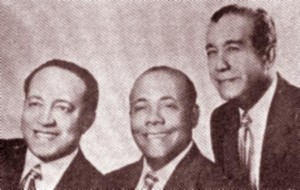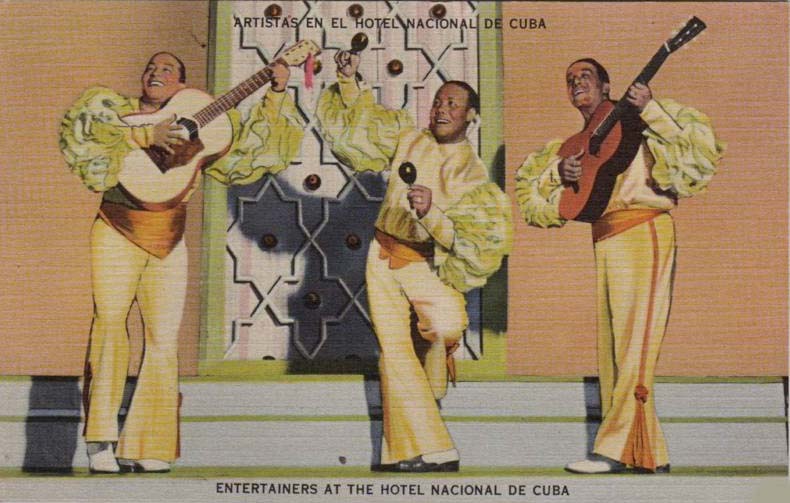CUBAN MUSIC HISTORY: “EL TRIO MATAMOROS”.
The Trio Matamoros were one of the most popular Cuban trova groups. Formed in 1925 by Miguel Matamoros (Santiago de Cuba, 8 May 1894 – 15 April 1971; guitar), Rafael Cueto (Santiago de Cuba, 14 March 1900 – 7 August 1991; guitar) and Siro Rodriguez (Santiago de Cuba, 9 December 1899 – Regla, 29 March 1981; maracas and claves). All three were singers and composers.
During nearly four decades of their musical career, the Trío Matamoros sang with love for the beauty and the people of their dearly beloved homeland.
With a unique Cuban style, Miguel Matamoros founded and directed the world famous musical group that carried his name and that traveled the world like vibrant musical ambassadors using only their voices, guitars and maracas as their flag. They added an unequaled Cuban flavor to each performance that nobody has been able to attain since then.
The founder and director of this renowned Trío created other genres within the established norms of the bolero and the criolla song styles. These added a large body of work to the vast repertoire of the Cuban ‘songbook’ known for its high melodic and rhythmic quality, thus enriching the Cuban cultural patrimony.
The Trio Matamoros played boleros and son. They toured all Latin America and Europe and recorded in New York. In 1940 Guillermo Portabales performed with the trio. Matamoros expanded the trio into a conjunto for a trip to Mexico and hired the young Beny Moré as singer from 1945 to 1947. They recorded many 78rpm records and LPs; some of their output is available on CDs. The group were renowned for the harmony of their voices, and the quality of the lyrics.
In songs such as Son de la Loma, El que siembra su maíz and Lágrimas Negras, the emblematic Miguel Matamoros majestically fused two of the most popular genres of our popular music for the first time (the bolero and the son).
Other popular numbers such as Juramento, Olvido, Mientes, Alegre Conga, Reclamo, Místico, Mariposita de Primavera, Triste muy triste and El Paralítico, just to name a few of the more well known ones, demonstrate the endless creativity of the world renowned author, Miguel Matamoros.
Miguel Matamoros together with Siro Rodríguez and Rafael Cueto made up the most famous of Cuban Tríos. In 1928 alone they recorded ten albums with RCA Victor record label. El que siembra su maíz and Olvido are the numbers that launched his career and made him world famous.
Born in Santiago de Cuba in l894, Miguel Matamoros passed away in 1971. During his 77 years, he dedicated more than four decades to entertaining not only his compatriots, but the entire world with his enduring and beautiful creations.
This Trío was known for taking their work seriously, staying faithful to the music and always interpreting the music with good taste. These were the characteristics they were known for and they were born from the true brotherhood the members felt for each other in their art and in their personal lives.
The distinguished musicologist from Santiago, José Julián Padilla Sánchez once said of Miguel Matamoros that “he could express a Cuban ‘criollo’ style artistically, and at the same time maintain his own personal style which he used to creat and interpret his music.”
With regard to the Trío, Padilla said, “The characteristic sound of the Trío Matamoros is due to the voice and lead guitar of its director who possesses an instrumental melody line with “punteado” style. This is enriched by the second voice of Siro with a rich baritone quality and Cueto’s guitar, known for a very expressive strumming style and a “tumbao” all his own, resulting in a sort of polyrhythmic effect.”
Matamoros was one of the greatest and most prolific composers of the Cuban son; his first hit was El que siembra su maiz (literally, he who sows his corn). Lágrimas negras (Black tears) and Mamá, son de la loma / y cantan en llano (Ma, they’re from the hill, and they sing on the plain, meaning, they’re from Oriente and they sing in Havana). The group, whose members stayed together for 35 years, disbanded in 1960.
Miguel Matamoros also contributed the so-called “pasacalles guitarísticos” which he created with a unique exhuberant native flavor, complemented by Cueto’s third voice in the chorus of the sons.
Thirty years since the passing of Miguel Matamoros, the eco of Siro, Cueto and Miguel can still be heard. This famous Trío sings on in the most distant plazas on the planet, a source of pride for not only Cubans, but for all who love our popular music.
Agencies/wiki/Barcelo/InternetPhotos/YouTube/Arnoldo Varona/TheCubanHistory.com
THE CUBAN HISTORY, HOLLYWOOD.
LEYENDAS MUSICALES CUBANAS: “EL TRÍO MATAMOROS”.
Trío Matamoros fueron uno de los grupos de trova cubanos más populares. Formado en 1925 por Miguel Matamoros ( Santiago de Cuba , mayo 8, 1894 hasta abril 15, 1971 ; guitarra), Rafael Cueto ( Santiago de Cuba , marzo 14, 1900 a agosto 7, 1991 ; guitarra) y Siro Rodríguez ( Santiago de Cuba , 09 de diciembre 1899 – Regla 29 de marzo de 1981; maracas y claves ) . Los tres eran cantantes y compositores.
Durante casi cuatro décadas de su carrera musical, el Trío Matamoros cantó con amor por la belleza y la gente de su muy querida y amada patria.
Con un estilo cubano único, Miguel Matamoros fundó y dirigió el grupo musical de fama mundial que lleva su nombre y que viajó por el mundo como embajadores musicales vibrantes utilizando sólo sus voces , guitarras y maracas como su bandera. Añadieron un sabor cubano inigualable para cada actuación que nadie ha sido capaz de alcanzar desde entonces.
El fundador y director de este reconocido Trío crearon otros géneros dentro de las normas establecidas del bolero y los estilos de la canción criolla . Éstos añaden una gran cantidad de trabajo para la gran repertorio del ” cancionero ” cubano conocido por su alta calidad melódica y rítmica , enriqueciendo así el patrimonio cultural cubano .
El Trío Matamoros jugó boleros y el hijo . Recorrieron toda América Latina y Europa y grabaron en Nueva York. En 1940 Guillermo Portabales realizó con el trío . Matamoros se expandió el trío en una de conjunto para un viaje a México y contrató a los jóvenes Beny Moré como cantante 1945-1947 . Grabaron muchos discos de 78 rpm y LPs , algunos de su producción está disponible en CD. El grupo eran famosos por la armonía de sus voces y la calidad de las letras.
En canciones como Son de la Loma , El Que Siembra Su Maíz y Lágrimas Negras , el emblemático Miguel Matamoros majestuosamente fusiona dos de los géneros más populares de nuestra música popular , por primera vez ( el bolero y el hijo ) .
Otros números populares como Juramento, Olvido, Mientes , Alegre Conga, Reclamo , Místico , Mariposita de Primavera , Triste muy triste y El Paralítico , sólo para nombrar algunos de los más bien conocidos , demuestran la infinita creatividad del mundialmente conocido autor , Miguel Matamoros.
Miguel Matamoros junto a Siro Rodríguez y Rafael Cueto hizo el más famoso de los Tríos cubanos. Sólo en 1928 se registraron diez discos con sello discográfico RCA Victor . El Que Siembra Su Maíz y Olvido son los números que lanzó su carrera y lo hizo mundialmente famoso .
Nacido en Santiago de Cuba en l894 , Miguel Matamoros falleció en 1971 . Durante sus 77 años , dedicó más de cuatro décadas para entretener no sólo a sus compatriotas , sino al mundo entero con sus creaciones duraderas y bellas .
Este trío fue conocido por tomar en serio su trabajo , permaneciendo fiel a la música y siempre la interpretación de la música con buen gusto. Estas fueron las características que fueron conocidos por y nacieron de la verdadera hermandad los miembros sentían el uno al otro en su arte y en su vida personal .
El distinguido musicólogo de Santiago , José Julián Padilla Sánchez dijo una vez de Miguel Matamoros que ” él podría expresar un estilo cubano criollo artistically , y al mismo tiempo mantener su propio estilo personal que utilizó para conformar e interpretar su música. ”
En relación con el Trío , Padilla dijo: ” El sonido característico del Trío Matamoros se debe a la voz y guitarra principal de su director que posee una línea de melodía instrumental con ” estilo punteado ” . Esto se enriquece con la segunda voz de Siro con una calidad rica voz de barítono y la guitarra de Cueto , conocido por un estilo de rasgueo muy expresivo y un ” tumbao ” todas las suyas, lo que resulta en una especie de efecto polirrhythmic . ”
Matamoros fue uno de los más grandes y más prolíficos compositores del son cubano , y su primer éxito fue El Que Siembra Su Maiz (literalmente : El que siembra su maíz ) . Lágrimas negras (lágrimas Negro) y Mamá , el hijo de la loma / y cantan en llano ( Ma , son de la colina, y cantan en el llano , es decir, que son de Oriente y cantan en La Habana ). El grupo, cuyos miembros permanecieron juntos durante 35 años, se separó en 1960 .
Miguel Matamoros también contribuyó a los llamados ” pasacalles guitarísticos ” que él creó con un sabor nativo exuberante única , complementada por la tercera voz de Cueto en el coro de los hijos .
Treinta años después de la muerte de Miguel Matamoros, el eco de Siro, Cueto y Miguel todavía se pueden oír . Este famoso Trío canta en las plazas más distantes del planeta, un motivo de orgullo no sólo para los cubanos , sino para todos los que aman nuestra música popular.
Agencies/wiki/Barcelo/InternetPhotos/YouTube/Arnoldo Varona/TheCubanHistory.com
THE CUBAN HISTORY, HOLLYWOOD.
Area Rural de Quivican. Es considerado como uno de los veinte pueblos más antiguos de toda Cuba.
FOTO por Jasmine Gestini






